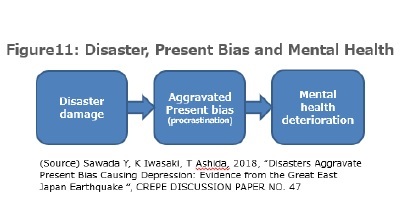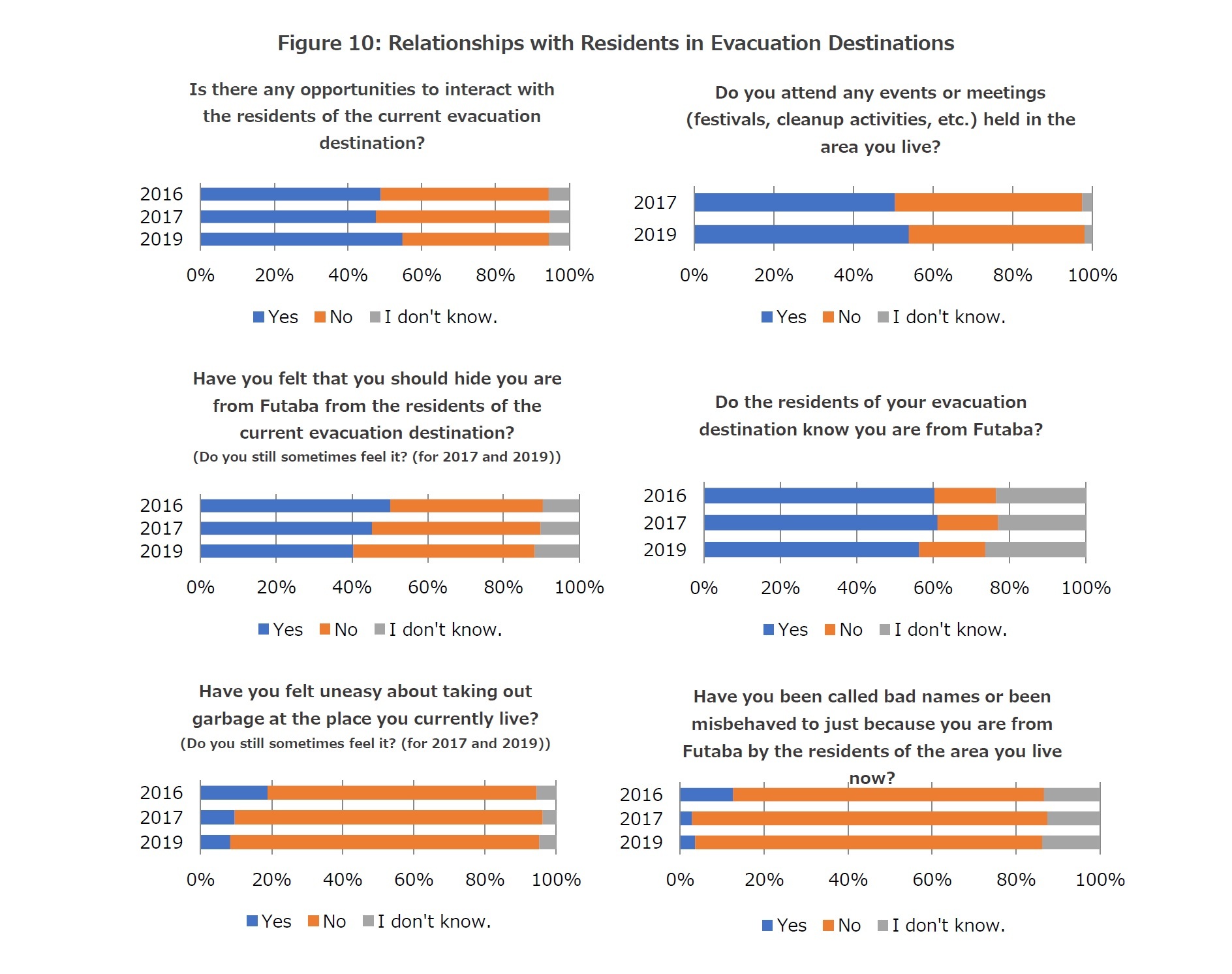- シンクタンクならニッセイ基礎研究所 >
- 暮らし >
- ライフデザイン >
- Damage, Living Environment, and Reconstruction Under the Great East Japan Earthquake-The 5th Survey of Nuclear Disaster Evacuees from Futaba, Fukushima, Summary of Results 2019
Damage, Living Environment, and Reconstruction Under the Great East Japan Earthquake-The 5th Survey of Nuclear Disaster Evacuees from Futaba, Fukushima, Summary of Results 2019

保険研究部 准主任研究員 岩﨑 敬子
このレポートの関連カテゴリ
文字サイズ
- 小
- 中
- 大
4――Building Relationships with Residents at Evacuation Destinations
5――Relationship Between Damage and Present Bias
 We found exposure to a disaster aggravates an individual’s present bias and this causal relationship can be a key mechanism behind the disaster and mental health deterioration nexus (see Figure 1). Present bias is an individual's procrastination tendency known to be intimately linked to harmful behaviors against health, such as overeating, smoking, and excessive alcohol drinking. In disaster affected areas, various activities and policies to improve health and to encourage communication have been introduced, such as regular lunch programs, radio gymnastics and other events, the installation of free running machines in community centers, and the use of architectural design in public reconstruction housing which encourages interactions among residents. These activities and policies are considered to prevent the deterioration of mental health caused by procrastination tendencies, and our study results support the effectiveness of such activities and policies. However, it should be noted that not everyone faces aggravation of present bias or mental health deterioration after a disaster and the purpose of our study is to provide policy implications.
We found exposure to a disaster aggravates an individual’s present bias and this causal relationship can be a key mechanism behind the disaster and mental health deterioration nexus (see Figure 1). Present bias is an individual's procrastination tendency known to be intimately linked to harmful behaviors against health, such as overeating, smoking, and excessive alcohol drinking. In disaster affected areas, various activities and policies to improve health and to encourage communication have been introduced, such as regular lunch programs, radio gymnastics and other events, the installation of free running machines in community centers, and the use of architectural design in public reconstruction housing which encourages interactions among residents. These activities and policies are considered to prevent the deterioration of mental health caused by procrastination tendencies, and our study results support the effectiveness of such activities and policies. However, it should be noted that not everyone faces aggravation of present bias or mental health deterioration after a disaster and the purpose of our study is to provide policy implications.
6―― Summary of Findings from the Five Rounds of Surveys
(2) In particular, there was a possibility that the mental health of those who had lived in temporary shelters for a long time was in a serious condition. However, currently, even after many of the residents have already moved from temporary shelters to public reconstruction housing, the mental health of residents in public reconstruction housing tends to be in a serious condition, and continuous support is important.
(3) As to changes in income and health condition caused by the disaster, we find that the greater the extent of decrease or deterioration is, the greater the degree of decline in individual well-being tends to be. This implies the necessity of sufficient compensation so that the original state of the survivors’ well-being can be recovered.
(4) The disaster has weakened the social capital of Futaba residents, and recovery may take a very long time.
(5) Keeping in touch with friends from pre-disaster times as well as participating in hobbies and volunteer activities after the disaster may help people maintain good mental health.
(6) Though relationship building with the residents of the evacuation destinations shows some gradual progress, the progress is subtle and it is still thought to be an important challenge that evacuees are facing.
(7) Aggravated present bias (procrastination tendencies) due to disasters can lead to a decline in mental health condition, but policies that promote interaction among residents and encourage good health behaviors can prevent such a decline.
These results have been presented at international and domestic academic conferences. In addition, these results have been published in international academic journals. We intend to continue our analysis and contribute to the improvement of disaster preparation/rehabilitation policies.
Our survey results are based on aggregates and analyses of responses from approximately 24% of the households of Futaba and do not represent all Futaba residents. Since the survey was conducted after a major disaster, the characteristics of respondents may be very different from general surveys and there is a possibility of an overestimation in our results due to the deterioration of physical and mental health conditions. Therefore, special caution is required in interpreting the results, and any definitive judgments based solely on these findings should be avoided.
(2020年03月11日「基礎研レポート」)
このレポートの関連カテゴリ
関連レポート
- 「東日本大震災による被害・生活環境・復興に関するアンケート」2019年調査結果概要-福島県双葉町民を対象とした第5回調査
- 「東日本大震災による被害・生活環境・復興に関するアンケート」2017年調査結果概要-福島県双葉町民を対象とした第4回調査
- 「東日本大震災による被害・生活環境・復興に関するアンケート」2016年調査結果概要-福島県双葉町民を対象とした第3回調査
- 「東日本大震災による被害・生活環境・復興に関するアンケート」2014年調査結果概要-福島県双葉町民を対象とした第2回調査
- 「東日本大震災による被害・情報取得経路・復興に関するアンケート」2013年調査結果概要-福島県双葉町民を対象とした第1回調査

03-3512-1882
- 【職歴】
2010年 株式会社 三井住友銀行
2015年 独立行政法人日本学術振興会 特別研究員
2018年 ニッセイ基礎研究所 研究員
2021年7月より現職
【加入団体等】
日本経済学会、行動経済学会、人間の安全保障学会
博士(国際貢献、東京大学)
2022年 東北学院大学非常勤講師
2020年 茨城大学非常勤講師
岩﨑 敬子のレポート
| 日付 | タイトル | 執筆者 | 媒体 |
|---|---|---|---|
| 2025/06/30 | マスク着用の子どもへの影響-コロナ禍の研究を経て分かっていること/いないこと | 岩﨑 敬子 | 基礎研レポート |
| 2025/06/26 | マスク着用のコミュニケーションへの影響(2)-コロナ禍の研究を経て分かっていること/いないこと | 岩﨑 敬子 | 基礎研レター |
| 2025/06/23 | マスク着用のコミュニケーションへの影響(1)-コロナ禍の研究を経て分かっていること/いないこと | 岩﨑 敬子 | 基礎研レター |
| 2025/06/19 | マスク着用のメンタルヘルスへの影響(2)-コロナ禍の研究を経て分かっていること/いないこと | 岩﨑 敬子 | 基礎研レター |
新着記事
-
2025年10月24日
米連邦政府閉鎖と代替指標の動向-代替指標は労働市場減速とインフレ継続を示唆、FRBは政府統計を欠く中で難しい判断を迫られる -
2025年10月24日
企業年金の改定についての技術的なアドバイス(欧州)-EIOPAから欧州委員会への回答 -
2025年10月24日
消費者物価(全国25年9月)-コアCPI上昇率は拡大したが、先行きは鈍化へ -
2025年10月24日
保険業界が注目する“やせ薬”?-GLP-1は死亡率改善効果をもたらすのか -
2025年10月23日
御社のブランドは澄んでますか?-ブランド透明性が生みだす信頼とサステナビリティ開示のあり方(1)
レポート紹介
-
研究領域
-
経済
-
金融・為替
-
資産運用・資産形成
-
年金
-
社会保障制度
-
保険
-
不動産
-
経営・ビジネス
-
暮らし
-
ジェロントロジー(高齢社会総合研究)
-
医療・介護・健康・ヘルスケア
-
政策提言
-
-
注目テーマ・キーワード
-
統計・指標・重要イベント
-
媒体
- アクセスランキング
お知らせ
-
2025年07月01日
News Release
-
2025年06月06日
News Release
-
2025年04月02日
News Release
【Damage, Living Environment, and Reconstruction Under the Great East Japan Earthquake-The 5th Survey of Nuclear Disaster Evacuees from Futaba, Fukushima, Summary of Results 2019】【シンクタンク】ニッセイ基礎研究所は、保険・年金・社会保障、経済・金融・不動産、暮らし・高齢社会、経営・ビジネスなどの各専門領域の研究員を抱え、様々な情報提供を行っています。
Damage, Living Environment, and Reconstruction Under the Great East Japan Earthquake-The 5th Survey of Nuclear Disaster Evacuees from Futaba, Fukushima, Summary of Results 2019のレポート Topへ



















 各種レポート配信をメールでお知らせ。読み逃しを防ぎます!
各種レポート配信をメールでお知らせ。読み逃しを防ぎます!




